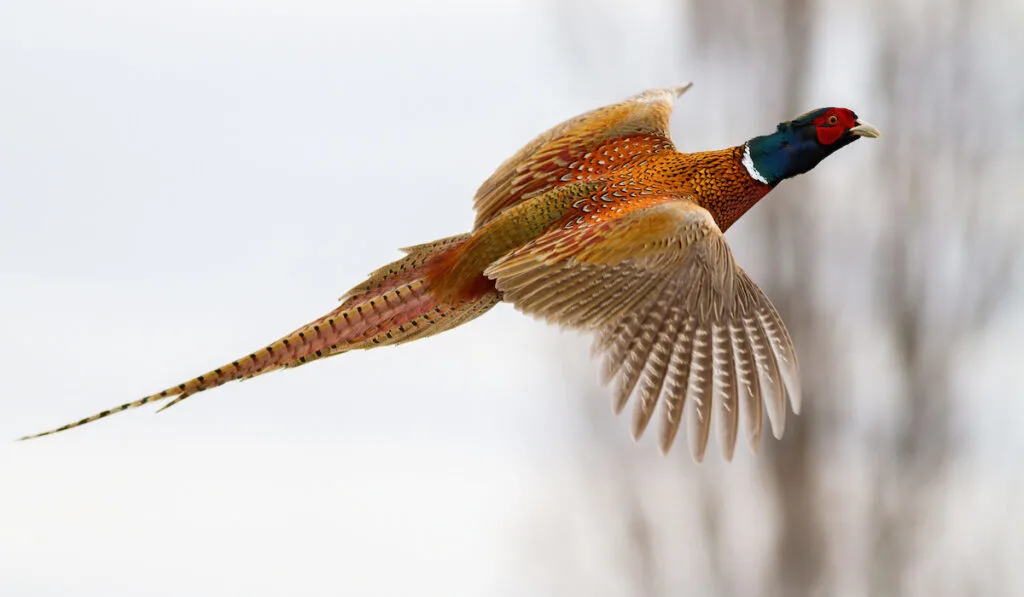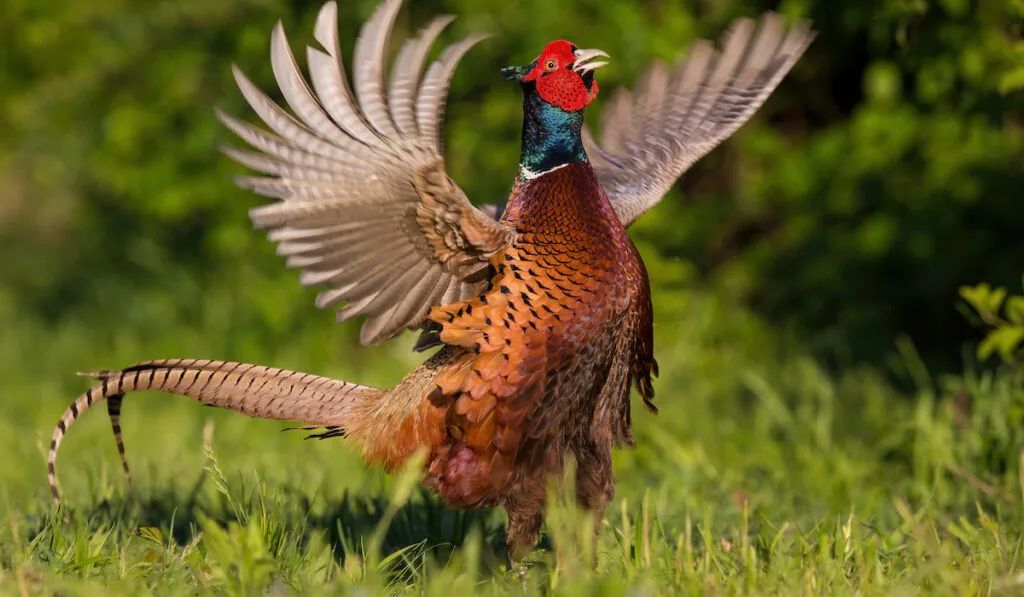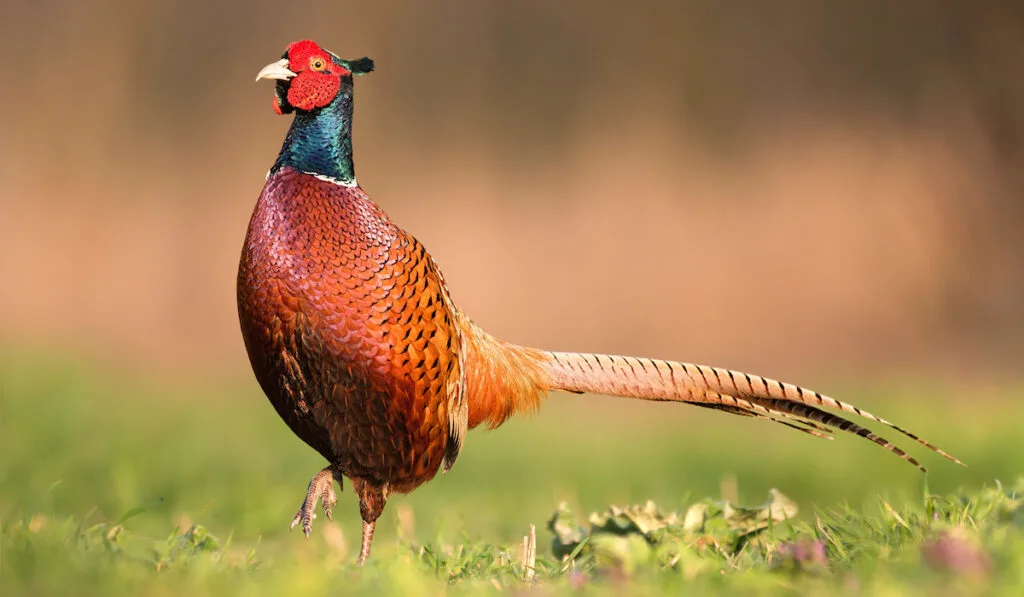Like every other bird, pheasants have wings. But as you may already know, having wings does not confirm that a bird can fly. Now, does this apply to pheasants? Let us see.
Can pheasants fly?
Pheasants can fly. However, they are more at ease on the ground, where they can readily forage for insects, seeds, grains, and much more. When pheasants do fly, they typically do so only for short distances.

You might be wondering why pheasants only fly for short distances. Well, we discuss that and much more in the rest of this article.
Table of Contents
Can Pheasants Fly?
Pheasants can fly; their flight is powerful and abrupt, and their takeoff is typically noisy. These characteristics are, in part, due to their powerful flight muscles.
While pheasants can fly, they usually only do so for short distances. In fact, more times than not, they run from trouble instead of flying.
Yet, interestingly, they fly faster than they can run. On average, pheasants fly as fast as 40 mph, but their average running speed is about 8 to 10 miles per hour.
Due to the explosiveness of their flight, pheasants use a lot of energy to fly. And this is one reason they only fly for short distances.
Besides that, pheasants do not have the endurance that birds that fly for long distances do. So, they typically just have short bursts of flight when it is absolutely necessary.
Then again, their primary sources of food are on the ground. So, it is more comfortable for them to just move around by walking.
How Far Will Pheasants Travel When Flying?
Due to the high amount of energy that goes into their flights, pheasants typically only fly for about 2 km (1.24 miles) or less.
How Fast Do Pheasants Fly?
When just cruising, pheasants fly at a speed of around 38 to 48 mph. But when running from a predator or being chased, they can fly as fast as 60 mph.

When Do Pheasants Start Flying?
The wing feathers of pheasant chicks develop before other feathers. By the time they are 12 days old, pheasants may start flying.
How Do Pheasants Survive Winter?
Since pheasants do not fly for long distances, they typically do not migrate out of their habitat. Even when winter comes, they will most probably remain in their home area.
Now, you might be wondering how pheasants survive in winter. Well, a pheasant’s survival in winter largely depends on the composition of its habitat.
Ordinarily, cold temperatures do not pose dire threats to pheasants.
During the seasons of abundant food, pheasants consume enough to create a dense layer of fat beneath their skin.
This fat layer typically makes up around 10 to 15% of their total body weight, and it helps them resist cold temperatures.
However, a dense fat layer is not all pheasants need to survive winter. In fact, it is not the most vital factor for pheasants to survive winter. Having dense structures that can break wind and keep the snow back is the most crucial factor for the survival of pheasants in winter.
Blizzards (snow set in motion by strong winds) are the prime threat to pheasants in winter. When pheasants are exposed to blizzards, some snow gets beneath their feathers and freezes them. When this happens, thermoregulation becomes impossible.
Besides freezing their feathers, blizzard snow can also get in the airways of pheasants. When this happens, ice will accumulate in their airways and block them. Consequently, the pheasants suffocate and die.
With structures that can break wind, pheasants are more likely to survive winter. Such shelters like beefy shelterbelts, cattail marshes, and native grasses create a space with a mild microclimate for the birds. This way, they escape the damaging effects of blizzards.
Now, besides the above, having food close to the shelter is also crucial to the survival of pheasants. With proximal food sources, pheasants will not have to go through the risk of foraging in snowstorms to feed.
Given all the necessary factors, pheasants have a survival rate of up to 95% in winter. But in a severe winter, the survival rate may be as low as 50%, even in the appropriate habitat.
Even when the habitat is not ideal, pheasants have a survival rate of around 80% in a mild winter. But in severe winter, this survival rate without idea habitat drops to about 20%.

Can Pheasants Swim?
While they would prefer to remain on land, pheasants can also swim when they have to.
Conclusion
It might not be a common sight, but pheasants can fly.
However, for most parts of their existence, they choose to remain on the ground. Walking is more comfortable for pheasants because they cannot endure long flights, and their flights are highly energy-consuming. Also, they get most of their diet from food items on the ground, so walking makes feeding easier for them.
Resources
- https://www.nationalgeographic.com/animals/birds/facts/common-pheasant
- https://www.livingwithbirds.com/tweetapedia/21-facts-on-pheasant
- https://www.livescience.com/57139-why-chickens-cannot-fly.html
- https://pheasantsforever.org/BlogLanding/Blogs/Pheasants-Forever/Microclimate-How-Ringnecks-Beat-Winter.aspx?feed=articles
- https://www.softschools.com/facts/animals/pheasant_facts/656/
